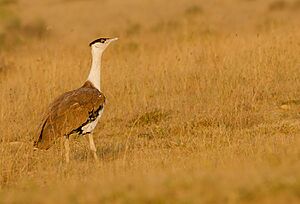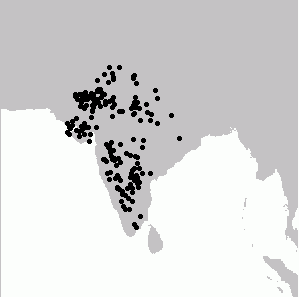Great Indian bustard facts for kids
Quick facts for kids Great Indian bustard |
|
|---|---|
 |
|
| At Naliya grasslands, Kutch, India | |
| Conservation status | |
| Scientific classification | |
 |
|
| Points where the species has been recorded. Once widespread, the species is today found mainly in central and western India. | |
| Synonyms | |
|
Choriotis nigriceps, Eupodotis edwardsi, Otis nigriceps |
The great Indian bustard (Ardeotis nigriceps) is a very large bird found in India. It has a big body, long legs, and is one of the heaviest birds that can fly. These birds used to be common in the dry grasslands and shrublands of India. Sadly, by 2018, only about 150 were left, down from 250 in 2011. This makes them Critically Endangered. Their numbers have dropped because of hunting and losing their homes. The great Indian bustard is protected by Indian law.
Contents
About the Great Indian Bustard
The great Indian bustard is a tall ground bird, standing about one meter (3.3 feet) high. It is easy to spot with its black cap on a pale head and neck. Its body is brownish with a black patch that has white spots.
Differences Between Males and Females
Male bustards are a deep sandy color. During the breeding season, they have a black band across their chest. The top of their head is black and can be puffed up when they are trying to attract a mate. Females are smaller than males. Their heads and necks are not as purely white, and their chest band is often faint or missing.
Special Features
Among all bustard species, the great Indian bustard is smaller only than the Kori bustard and the great bustard. It is also the largest land bird in the areas where it lives.
Males have a special throat pouch called a gular pouch. They can inflate this pouch when they make their deep, booming calls during mating displays. This helps their calls travel far. Very rarely, some bustards have been seen with unusual white patches, or even nearly all white, due to a condition called leucism.
Where They Live and Their Home
The great Indian bustard used to live across much of India and Pakistan. Today, they are found in much smaller, separate areas. These include parts of Rajasthan, Karnataka, Maharashtra, Madhya Pradesh, and Gujarat in India. A few birds have also been seen in the Cholistan Desert in Pakistan.
Preferred Habitat
These birds live in dry and semi-dry grasslands. They also like open areas with thorny bushes and tall grass mixed with farms. They tend to avoid places that are heavily irrigated (watered for farming). The main areas where they breed are in central and western India and eastern Pakistan. Some dry desert regions in Rajasthan, where they once lived, have changed into heavily farmed areas due to irrigation canals. This change has made these places unsuitable for the bustards.
Behaviour and Life Cycle
The great Indian bustard eats both plants and animals, making it an omnivorous bird.
Diet
Their favorite food is insects, especially grasshoppers and beetles. They also eat grass seeds, berries (like those from the Ziziphus plant), rodents, and small reptiles. In Rajasthan, they hunt Indian spiny-tailed lizards. In farm areas, they eat crops like peanuts, millets, and beans. They drink water when it's available, sometimes sitting down to sip it.
Social Life
Male bustards are polygamous, meaning they mate with more than one female. During the breeding season, males are usually alone. In winter, they gather in small groups. They are thought to use a special mating system where males display themselves in spread-out areas, rather than one central spot. Great Indian bustards move around locally, but scientists don't fully understand these movements. Flocks tend to spread out after the rainy season.
Reproduction
Breeding happens between March and September. During this time, the male bustard inflates his fluffy white feathers to show off. Males might fight each other by strutting, leaping, and locking necks.
When a male courts a female, he inflates his gular sac, which hangs like a large, wobbly bag from his neck. He also holds his tail up over his back. The male makes a deep, booming call that can be heard from almost 500 meters away.
The female lays a single egg directly on the ground in a simple nest. Only the female takes care of the egg and the young. Eggs are at risk from other animals like grazing animals and crows. Females might pretend to be injured, flying in a zigzag pattern with dangling legs, to distract predators from their nest.
Threats to Survival
The great Indian bustard has been listed as Critically Endangered since 2011. This means it faces a very high risk of becoming extinct.
Habitat Loss and Hunting
The species has disappeared from 90% of the areas where it once lived. In 2008, there were likely fewer than 250 individuals left. The main dangers are hunting and losing their natural homes. In the past, they were hunted a lot for their meat and for sport. Even today, illegal hunting (poaching) might still happen. In some places, like Rajasthan, new irrigation canals have led to more farming. This change in habitat has caused the bustards to disappear from these regions.
Modern Dangers
Today, new dangers include roads and power lines in the desert. Birds can collide with these structures and die. Plans to build more solar panel farms in large desert and grassland areas also threaten the bird's habitat. Some bustard populations move into Pakistan, where hunting is a big problem. The great Indian bustard is critically endangered in Pakistan mainly because it lacks protection and hunting is widespread.
At the Ranibennur Blackbuck Sanctuary, changes to the habitat have also affected wildlife. In the 1950s, the scrub forest was replaced with Eucalyptus trees. These trees helped wildlife when they were small, but as they grew tall, they made the nearby grasslands less suitable for bustards. Attempts to breed these birds in zoos in the 1970s were not successful.
Conservation Efforts
The state of Rajasthan started "Project Great Indian Bustard" on World Environment Day in 2013. This project aims to find and protect bustard breeding areas within existing wildlife sanctuaries. It also works to create safe breeding enclosures in areas outside protected zones. In 2020, nine bustard chicks were successfully hatched in captivity, which was a world record!
Evolutionary History
Studies of the great Indian bustard's DNA show that they have low genetic diversity. This suggests that their population size dropped significantly about 20,000 to 40,000 years ago.
The Bustard in Culture
The great Indian bustard has been mentioned in history and culture. The Mughal emperor Babur once wrote that the meat of the Kharchal (great Indian bustard) was delicious in every part. British soldiers in India also considered it a prized game bird.
The bustard was a challenging bird to hunt because it was secretive and wary. Hunters had to be very careful to get close enough. The invention of the Jeep made hunting much easier, as hunters could chase the birds down in their open habitats.
Names and Meanings
The name hoom is used in parts of Maharashtra. It comes from the bird's low, booming call. Its sharp, barking alarm call led to the name hookna in some parts of northern India. In other areas, it is called Gaganbher or Gurayin because some of its calls sound like thunder or a tiger's roar.
When India was choosing its national bird, the great Indian bustard was a strong candidate. The famous Indian bird expert Salim Ali supported it. However, the Indian peafowl was chosen instead, partly because the name "bustard" could be easily misspelled.
Images for kids
-
From Thomas Hardwicke's Illustrations of Indian Zoology (1830–1835)
-
Eggs of the species in comparison to the smaller ones of the lesser florican





